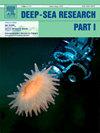Variability of the Weddell Sea deep waters in GLORYS12v1 reanalysis
IF 2.1
3区 地球科学
Q2 OCEANOGRAPHY
Deep-Sea Research Part I-Oceanographic Research Papers
Pub Date : 2025-09-26
DOI:10.1016/j.dsr.2025.104599
引用次数: 0
Abstract
Understanding deep-water variability in the Weddell Sea remains a challenge, given the limited observational coverage and the difficulties ocean models face in representing fine-scale processes, particularly along the Antarctic margin. Recent high-resolution oceanic products offer a valuable opportunity to advance understanding of this region. Nevertheless, it is crucial to critically evaluate their reliability before relying on them for scientific analysis. Here, we assess the representation and variability of Warm Deep Water (WDW), Weddell Sea Deep Water (WSDW), and Weddell Sea Bottom Water (WSBW) in the 1/12° Global Ocean Physics Reanalysis (GLORYS12v1) between 1993 and 2020. GLORYS12v1 reproduces key hydrographic features and vertical stratification below 500 m, despite persistent biases in the upper ocean. WDW shows a spurious freshening trend and a cool bias in Section SR4, diverging from the observed neutral salinity and warming trend. Moreover, WSDW and WSBW exhibit overestimated warming and salinification trends. These discrepancies are primarily linked to (i) a weakening of the Weddell Gyre, which limits inflow and renewal of deep waters; (ii) stronger westerlies enhancing Ekman transport and upwelling; and (iii) changes in sea ice concentration affecting deep convection. A complex maximum covariance analysis reveals strong decadal-scale covariability between the Weddell Gyre barotropic circulation and the thermohaline structure of deep water masses, especially WSDW and WSBW. Although GLORYS12v1 resolves many relevant processes, its overestimation of trends and underrepresentation of coastal dynamics highlight the need for improved vertical coordinate schemes, refined mixing parameterizations, and enhanced observational coverage to better capture the variability of deep waters in polar regions.
在GLORYS12v1再分析中威德尔海深水的变率
考虑到有限的观测覆盖范围和海洋模式在代表精细尺度过程方面面临的困难,特别是在南极边缘,了解威德尔海的深水变化仍然是一个挑战。最近的高分辨率海洋产品为进一步了解该地区提供了宝贵的机会。然而,在依靠它们进行科学分析之前,批判性地评估它们的可靠性是至关重要的。在此,我们评估了1993 - 2020年1/12°全球海洋物理再分析(GLORYS12v1)中暖深水(WDW)、威德尔海深水(WSDW)和威德尔海底水(WSBW)的代表性和变率。GLORYS12v1再现了500米以下的关键水文特征和垂直分层,尽管在上层海洋中存在持续的偏差。在SR4剖面中,WDW表现出虚假的变冷趋势和偏冷趋势,偏离了观测到的中性盐度和变暖趋势。此外,WSDW和WSBW表现出高估的变暖和盐化趋势。这些差异主要与(1)威德尔环流的减弱有关,这限制了深水的流入和更新;(ii)较强西风带加强艾克曼运输及上升流;(三)影响深层对流的海冰浓度变化。复最大协方差分析表明,威德尔环流正压环流与深水团温盐结构,特别是与wsw和WSBW的温盐结构之间具有较强的年代际协变性。虽然GLORYS12v1解决了许多相关过程,但其对趋势的高估和对沿海动态的代表性不足,突出表明需要改进垂直坐标方案,改进混合参数化,并扩大观测覆盖范围,以便更好地捕捉极地深水的变率。
本文章由计算机程序翻译,如有差异,请以英文原文为准。
求助全文
约1分钟内获得全文
求助全文
来源期刊
CiteScore
4.60
自引率
4.20%
发文量
144
审稿时长
18.3 weeks
期刊介绍:
Deep-Sea Research Part I: Oceanographic Research Papers is devoted to the publication of the results of original scientific research, including theoretical work of evident oceanographic applicability; and the solution of instrumental or methodological problems with evidence of successful use. The journal is distinguished by its interdisciplinary nature and its breadth, covering the geological, physical, chemical and biological aspects of the ocean and its boundaries with the sea floor and the atmosphere. In addition to regular "Research Papers" and "Instruments and Methods" papers, briefer communications may be published as "Notes". Supplemental matter, such as extensive data tables or graphs and multimedia content, may be published as electronic appendices.

 求助内容:
求助内容: 应助结果提醒方式:
应助结果提醒方式:


